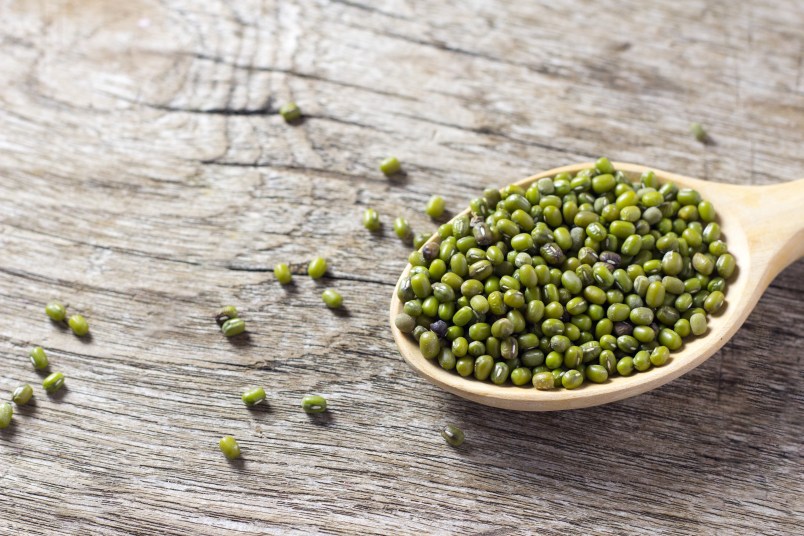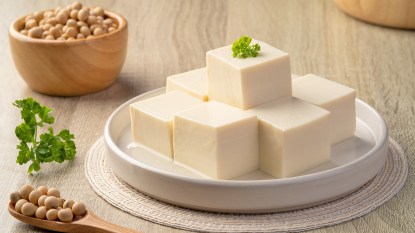7 Benefits of Mung Beans, The Weight-Loss Superfood That Could Be the Key to a Happy Gut

Ever heard of the mighty mung bean? If you haven’t, this small legume is about to become your new favorite superfood. Mung beans are button-sized, green or yellow little balls that grow natively in India, but are also used in traditional Chinese and Southeast Asian cooking.
The powerful mung bean has been known to have several health benefits, and is touted as one of the most nutrient-rich superfoods out there. Besides being simple to make and full of necessary vitamins, here are seven reasons to include mung beans in your diet — and how to do it right.
Health Benefits of Mung Beans
You’ll want to include mung beans in your diet for more reasons than one. The legumes are highly beneficial to your gut health, and they can help you meet a variety of health goals, including weight loss.
1. They’re rich in essential amino acids.
The body requires amino acids — the building blocks of proteins that make up our cells, muscles, and tissue — to function properly. In turn, essential amino acids can’t be produced by the body on its own (in other words, we can only get essential amino acids from our food). According to research, including mung beans in your diet is a great way to get essential amino acids like leucine, phenylalanine, lysine, and many more, which can help cells maintain their structure as we age.
2. They’re high in antioxidants.
Mung beans are naturally high in antioxidants like cinnamic acid, phenolic acid, and flavonoids. Antioxidants assist the body in neutralizing harmful free radicals that can cause disease and sickness in the body. Studies have shown that the reduction of free radicals is associated with a lower risk of cancer, heart disease, and other inflammatory diseases and disorders.
Mung beans are also particularly high in antioxidants like vitexin and isovitexin, which were shown to help alleviate symptoms of heat stroke. In fact, mung bean soup is often consumed in the hotter months in native Asian countries to help lower high body temperatures and cool down.
3. They can lower your risk of heart disease.
Generally, researchers have proposed that eating legumes helps to lower the risk of heart disease. More specifically, studies analyzing mung beans have shown that they can significantly lower “bad” LDL cholesterol levels, reducing one’s overall risk of developing heart disease. Scientists attribute this benefit to the high levels of antioxidants found in mung beans.
4. They’re good for your gut.
Mung beans are impressively high in fiber, boasting a whopping 15 grams per cooked cup of beans. In particular, mung beans are high in pectin, a kind of soluble fiber that benefits the gut by helping the body absorb water and move food through the digestive tract. Mung beans also have a significant amount of resistant starch, which contributes to healthy gut bacteria and soothes the lining of the stomach. Resistant starches encourage the production of butyrate, a short-chain fatty acid that is said to promote healthy colon cells and boost immunity in the gut.
5. They’re full of folate.
Folate, also known as vitamin B9, is required by the body to make new red and white blood cells, as well as to convert carbohydrates into energy. Mung beans are significantly high in folate, containing 80 percent of the recommended daily value in one cooked cup of beans. Folate is also particularly important during times of rapid growth in the body, such as during pregnancy.
6. They can help control blood sugar.
The compounds vitexin and isovitexin in mung beans have also been shown to lower blood sugar levels, which means that consuming mung beans can be helpful in managing diabetes. The fiber content in mung beans is also beneficial to those trying to control their blood sugar levels, as fiber is said to slow the absorption of sugar into the bloodstream.
7. They can help you lose weight (while feeling full) after menopause.
Foods that boast high fiber and protein content can control hunger. Studies suggest that foods high in both fiber and protein suppress the production of ghrelin — the hunger hormone — in the body. More specifically, another study analyzed the power of mung beans for postmenopausal women. Researchers found that mung beans helped postmenopausal women lose weight, attributing the success to the high fiber content of mung beans and its effect on how full one feels before and after meals.
How to Eat Mung Beans
Before adding mung beans to your diet, there are a few important things to note. Mung beans can be bought as whole dried beans or as sprouted beans. The sprouted variety is actually deemed more digestible than other legumes, and has been shown to contain higher levels of antioxidants and amino acids than the unsprouted beans. You can buy mung beans in either variety at your local healthfood store, or order them online from brands like ShaSha ($13.91, Amazon).
You can incorporate mung beans into your diet in a variety of ways. Before making the beans, be sure to soak them overnight or for a few hours before cooking. This improves the digestability of the beans. Once the beans are soaked, you can follow any mung bean recipe you like, boiling them plain or making them into a simple soup or a stew to serve as a side or as a main dish with rice.
More From FIRST
Lentils Can Reduce Blood Sugar Levels — If You Eat Them the Right Way
Why You Should Stock Up on Lupin Beans, The Latest Protein-Rich Superfood
Aquafaba Is the Liquid Egg-White Substitute That’s Been Hiding In Your Pantry This Whole Time













